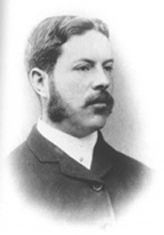Name William Graham | ||
 | ||
William Woodman Graham (c. 1859 – fl. 1932) was a British mountaineer who led the first pure mountaineering expedition to the Himalayas and may have set a world altitude record on Kabru.
Contents
Motivated by adventure rather than a desire for fame, Graham had little interest in publicising his climbs, and as a result relatively little is known about his life and achievements. He is known to have climbed extensively in the Alps, reaching most of the major summits and making the first ascent of the Dent du Géant in 1882. However, his application to join the Alpine Club was rejected for reasons which are unclear, but the size of the majority against him suggests that he had made influential enemies.
Himalayan expedition
In 1883, shortly after he had qualified as a barrister, Graham made a visit to the Himalayas in the company of Swiss Alpine guide Josef Imboden of St. Niklaus in the canton Valais. While many of the lower mountains of the Himalaya had been climbed by surveyors and explorers, mainly to make observations of more distant peaks, Graham was the first person to visit the range solely for the purpose of mountaineering. He spent the spring trekking in the region of Kanchenjunga, but he was forced to return to Darjeeling by the cold weather and the fact that a porter had accidentally burned his boots.
Once in Darjeeling, Imboden, who had contracted fever, was replaced by the Swiss guides Ulrich Kaufmann and Emile Boss, who had made the first ascent of Mount Cook the previous year. At the end of June the party set off for Garhwal where they explored the region around Nanda Devi. Unable to penetrate the Nanda Devi Sanctuary they turned their attention towards Dunagiri, where Graham claimed to have reached a height of around 22,700 ft (6,920 m) before being forced to retreat by bad weather.
Graham and his companions next attempted a nearby peak, which they believed was the one marked on the map as A21, now known as Changabang. They made an ascent by the West Ridge, which Graham described as "a fair climb, but [one that] presented no great difficulties." Modern observers, however, agree that whatever mountain Graham climbed it was not Changabang, which from the west presents a sheer wall which was not climbed until 1976, and certainly not the easy ridge that Graham described. It is more likely that he was on the wrong mountain; possibly a subsidiary summit on the southern ridge of Dunagiri.
Graham's confusion was partly due to the poor quality of the maps of the area, and on his return to civilisation he was critical of the Great Trigonometric Survey, suggesting that its surveyors should be trained in mountaineering by the Swiss Army, whom he credited with the finest cartographic work in the world at the time. The criticism was not well received by the Survey, and it may have made Graham more enemies to cast doubt on his accomplishments.
After the Garhwal trip, Graham and his companions returned to the Kanchenjunga area for the climax of their campaign; an attempt on Kabru, which Graham claimed to have climbed by the East Face in three days, reaching the summit on 8 September. Kabru, at 7,349 m (24,111 ft), was far higher than any other mountain climbed at the time, and its ascent was and remains the most controversial aspect of Graham's expedition. Doubt was cast on whether he really had climbed this mountain or whether he had mistaken a nearby, lower mountain called Forked Peak (6,200 m, 20,340 ft) for Kabru. His ascent was doubted by members of the GTS, and by contemporaries including Martin Conway and William Hunter Workman (both of whom had rival claims to the world altitude record). However, it was supported by climbers such as Norman Collie, Thomas Longstaff and Douglas Freshfield – Freshfield having travelled extensively in the same area himself. In his history of Himalayan climbing Kenneth Mason argued that Graham had not climbed Kabru, pointing to the vagueness of his description of the mountain, inconsistencies between his account and modern observations of the mountain, the remarkably quick ascent he claimed, and the fact that he appeared to have suffered little or no altitude sickness on his ascent. In a more recent history, Walt Unsworth argued that the vagueness of Graham's account was to be expected from a man who was a mountaineer rather than a surveyor, and that now Mount Everest has been climbed in a single day without oxygen, Graham's claims seem less outlandish than they once did, so that he should perhaps be credited with the ascent after all. The controversy remains unresolved.
Later life
After Kabru, Graham attempted several other mountains in the area, but the onset of winter prevented him from making serious progress on any of them. He disappeared from mountaineering history after his year in the Himalayas, and after making his initial report of his Himalayan expedition he never made any further comment or engaged in the ensuing controversy. For many years it was rumoured that he lost all his money and ended his days as a cowboy in the United States, but in fact he served as British Consul in Durango, Mexico, from 1910 until 1932. The year of his death is unknown.
